Most people are aware that high blood pressure is not a good thing.
If not properly controlled, hypertension can lead to serious damage in your arterial walls and make you a candidate for heart disease.
Although it’s well known that high blood pressure can be caused by things such as too much salt in your diet (along with too little potassium), being overweight, elevated cholesterol, smoking, stress and lacking exercise, it can also be triggered by these factors:
- Sugar and refined carbohydrate consumption
- Nutritional deficiencies, especially vitamins B2 (riboflavin), B12, B6 and folate, magnesium, antioxidants and omega-3 essential fatty acids
- Kidney problems
- Thyroid problems (hyperthyroidism)
- Heavy metal exposure, especially mercury, cadmium and copper
But the little-known other side of the blood pressure story—low blood pressure (aka hypotension)—presents its share of challenges too.
Let’s take a little closer look at this relatively obscure “sibling” in the blood pressure family, underlying factors that can cause it, and ways that you can help lower your risk of BOTH high blood pressure and low blood pressure.
Hypotension—how low can you go?
Hypotension is generally defined as having blood pressure lower than 90/60 in either of the numbers. In other words, if your systolic (top number) pressure is 90 or less OR your diastolic (bottom number) pressure is 60 or under, you’re considered to have low blood pressure.
Hypotension is characterized by these warning signs:
- Dizziness or lightheadedness
- Fainting (syncope)
- Lack of concentration
- Blurred vision
- Nausea
- Cold, clammy, pale skin
- Rapid, shallow breathing
- Fatigue
- Depression
- Thirst
Problem is, many of these symptoms are vague and/or associated with other conditions, so low blood pressure doesn’t always jump out as the culprit.
And although it doesn’t raise your heart disease risk like hypertension, it’s no peach either. Even moderate forms of low blood pressure can cause not only dizziness and weakness but also fainting and an increased risk of injury from falls.
Plus severely low blood pressure can deprive your body of adequate oxygen to carry out its normal functions, eventually leading to damage to your heart and brain!
How on earth?
Similar to high blood pressure, low blood pressure also is not really a stand-alone condition but the result of other factors or imbalances in the body.
Here are some of its common causes:
- Pregnancy
- Heart problems
- Endocrine system problems—thyroid conditions, adrenal insufficiency (Addison's disease), low blood sugar and diabetes
- Dehydration
- Blood loss—such as from a serious injury or internal bleeding
- Septicemia—this can occur when an infection in the body enters the bloodstream.
- Severe allergic reaction (anaphylaxis)
- Nutritional deficiencies—especially vitamin B12 and folate
- Medications—especially high blood pressure drugs, Parkinson’s disease drugs and antidepressants
It’s gotta go—whether it’s high or low!
Clearly both high and low blood pressure present their share of challenges, so it’s not only a good idea but can save your life if you:
1- Look at all the possible factors behind high or low blood pressure that may apply to you and
2- Support the proper functioning of your cardiovascular system!
Here are some strategies you can put into place to make a big difference in your numbers:
Get tested
Here are some tests you can ask your doctor to run:
- Urine tests--to check for protein and/or blood in your urine which would suggest kidney problems
- Hair or urine tests—to look for heavy metal exposure
- Blood tests--to check for elevated glucose, Type 2 diabetes and hyperthyroidism
- Blood levels of potassium, chloride, calcium, cholesterol, triglycerides and blood urea nitrogen and/or creatinine (for kidney function)
- C-reactive protein--CRP is a marker for inflammation. Levels of CRP rise when your blood vessels are inflamed, which may be a sign of atherosclerosis in the making
- Homocysteine—high levels of homocysteine in the blood can be dangerous because it can lead to out-of-control free radicals and arterial damage
- Blood nutrient analysis—to check for nutrient deficiencies, especially in the B vitamins
- Adrenal hormone testing
Have a healthy diet of real foods & encourage sound digestion
Having a healthy diet of real foods provides a triple whammy against blood pressure problems:
- You’ll be taking in natural sources of antioxidants (to fight free radicals) and water (to help prevent dehydration).
- You’ll be avoiding sugar and refined carbohydrates along with processed foods (that are loaded with sodium) while at the same time, eating more natural dietary sources of potassium.
- You’ll be encouraging better digestion and nutrient absorption, which will help correct any underlying nutrient deficiencies.
And the great news is, eating for better cardiovascular (and overall!) health is also easy and tastes fantastic.
That is, when you follow my Great Taste No Pain plan!
Great Taste No Pain will not only show you how to pair foods together to help encourage better digestion, but it will also give you a collection of luscious recipes featuring nutrient-packed foods that are out of sight.
One of the most common things we hear from people after they start using Great Taste No Pain is that they are shocked that eating right can taste so delicious!
Ensure your heart has the nutrients it needs
Your ticket here is Super Core Multi-Vitamin and Mineral Formula.
Super Core’s unique formula is jam-packed with nutrients that help support proper cardiovascular functioning.
These include vitamins B2, B12, B6 and folate (deficiencies of which are factors in both high and low blood pressure!), magnesium and zinc.
Plus Super Core takes a GIANT step beyong other nutrient formulas and provides the additional benefit of antioxidants and anti-inflammatories, which also support a healthy circulatory system!
Support a healthy gut environment with probiotics
Most people don’t realize that one of the ways your blood vessels can get into trouble is when you don’t eliminate old cholesterol like you should.
Typically your liver dumps old worn out cholesterol into your colon to be eliminated with your BMs.
But when you have poor digestion and/or constipation, the old cholesterol can instead get reabsorbed back into circulation.
Since probiotics help encourage healthy bowel movements, that can help your body eliminate the old cholesterol like it should!
Plus probiotics manufacture B vitamins (especially B6 and B12) which can reduce blood homocysteine levels and help encourage healthier blood pressure too.
The best way to consistently support a helathy gut microbiome is through supplementation with a top-notch, full-spectrum probiotic like Super Shield multi-strain probiotic formula.
Experts consistently recommend a probiotic formula that contains both Lactobacillus and Bifidobacterium species, and Super Shield’s 13 strains of well-studied, potent bacteria definitely fit the bill!
Both high and low blood pressure can be a serious cause for concern, so it’s crucial to make sure you correct any underlying factors that may be driving your pressure up or down, as well as support the health of your ticker and its vessels through diet and proper supplementation.
You’ll be glad you did!
To your health,
Sherry Brescia











